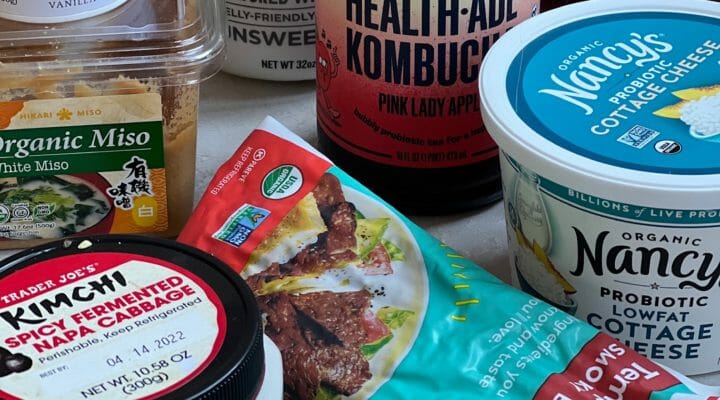How to Get a Healthy Gut

For the past several years, I’ve been nerding out on microbes. That’s for a very good reason. A growing body of evidence suggests that the bacteria in our GI tract are responsible for a lot more than just aiding digestion. Though much of the research is in its infancy, the findings have made me look at nutrition in a new way. It’s no longer just about vitamins and minerals, but also about how my diet can help or hinder that family of “good” gut bacteria. And so, I’m spreading the good news on how to get a healthy gut.
How to Get a Healthy Gut
There’s no doubt that interest in probiotic-rich foods is on the rise. Those are foods rich in good-for-you bacteria, such as yogurt and kombucha. Research uncovering links between our body’s bacterial population and health likely has something to do with it. Indeed, studies have demonstrated a potential link between gut bacteria and everything from obesity to autoimmune disease. Although research is still developing, one thing is certain, when it comes to microbes, strength comes in numbers. The higher the amount and variety, the greater potential for benefiting from these tiny bugs. Although the research has a way to go, thus far a healthy gut shows potential associations with:
- Decreasing inflammation
- Improving bowel regulation and decreasing risk of colon cancer
- Increasing immunity to disease, especially to those that impact the GI tract
- Decreasing incidence of food allergies and inflammatory gut diseases like Irritable Bowel Disease and Crohn’s Disease
- Decreasing incidence of obesity
- Improving mental health
What the Experts Say About Gut Health
According to Erica and Justin Sonnenburg, Stanford microbiologists and authors of The Good Gut: Taking Control of Your Weight, Your Mood, and Your Long-term Health![]() , the average American has about 1,200 bacterial populations, while tribes in the Amazon have up to 1,600. It seems that our western diets have diminished our healthy gut bacteria, potentially increasing our susceptibility to disease and inflammatory conditions. But don’t panic. These eight lifestyle modifications (let’s call it Gut Rehab) can help make your gut more microbe friendly.
, the average American has about 1,200 bacterial populations, while tribes in the Amazon have up to 1,600. It seems that our western diets have diminished our healthy gut bacteria, potentially increasing our susceptibility to disease and inflammatory conditions. But don’t panic. These eight lifestyle modifications (let’s call it Gut Rehab) can help make your gut more microbe friendly.
8 Tips for a Healthier Gut
Feed your bacterial residents.
Bacteria feast on fibrous foods (aka prebiotics) and need them for survival. Aim to eat fiber-rich foods, such as fruits, vegetables, nuts, seeds, whole grains, beans, or legumes at every meal, and ideally snack time, too.
Eat probiotic-rich foods regularly
Foods with “healthy” bacteria help prepare your resident gut bacteria to fight off potential harmful microbes in the future, which strengthens your immunity. Examples of probiotic-rich foods include yogurt, kefir, kombucha, miso, tempeh, and fermented vegetables such as kimchi, sauerkraut, and pickles of all kinds (buy refrigerated, not shelf-stable pickles).
Play in the dirt
Take up organic gardening, go hiking, or sit outside on the grass (no blanket needed) every now and then….all ways to pick up some healthy bacteria from the great outdoors.
Use antibacterial soaps and sanitizers wisely
Killing off all traces of bacteria in our environment with excessive use of antibacterials may be one reason our internal colonies are depleted. Regular soap and water for hand washing, particularly in our own homes, should do the trick in most cases.
Use antibiotics thoughtfully
There’s no doubt that kids sometimes need a dose of antibiotics, but overusing these medications is another reason our gut bacteria have suffered. Antibiotics kill off the pesky bad bugs, but the good ones too. If you do take antibiotics, be sure to include probiotic-rich foods in your diet and talk to your doctor about a probiotic supplement as well.
Cut down on processed food
Some research has shown that certain additives, such as artificial sweeteners, can alter gut bacterial colonies.
Focus on a plant-based diet
Foods such as red meat, saturated fat, and refined grains do not feed your gut bacteria, whereas the vegetables, fruits, legumes, and other whole foods within a plant-based diet do.
Know that it starts at the beginning
As someone who had my first child by C-section, I’m aware that a Caesarean birth is not typically a choice. That said, it’s worth knowing that delivering vaginally and breastfeeding start the formation of a child’s bacterial colonies, which they will carry for a lifetime.![]()
If you want to learn more about gut health, I suggest you tune into this interview with Dr. Erica Sonnenburg on the Meal Makeover Moms’ podcast. It’s fascinating stuff! And if you’d like to get a copy of her book, just click on the image above.
Thanks to dietetic intern Jen Beadles for help with this post. Disclosure: Mom’s Kitchen Handbook gets a tiny percentage of sales from affiliate links. It’s part of what helps keeps the engine running, so I appreciate your support.






Comments
06.25.2016 at4:22 PM #
Marisa | Marisa Moore Nutrition
“I’m just feeding my microbiota” – Love that little mantra! I can never get enough of this subject!
06.25.2016 at4:22 PM #
Katie Morford
Ditto, Marisa. And I feel like we’re just at the beginning…so much more we are going to learn on this subject!
02.05.2020 at10:30 AM #
Gloria
Awesome information! I’m headed to listen to Meal Makeover Mom’s Podcast and I plan to buy The Good Gut book too… Thanks!
02.05.2020 at10:30 AM #
Katie Morford
Oh Great! It’s a terrific episode.